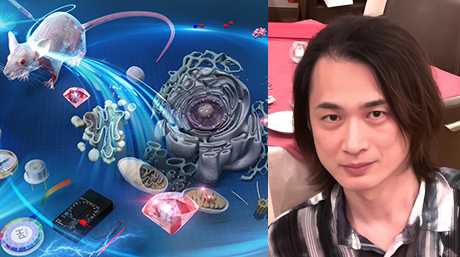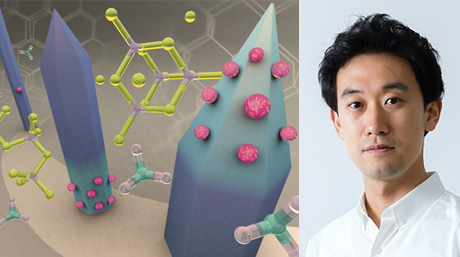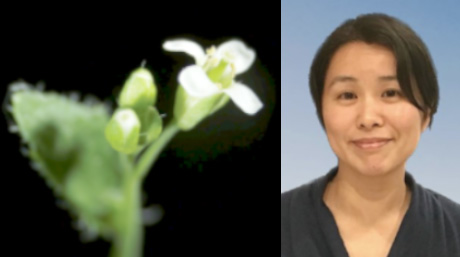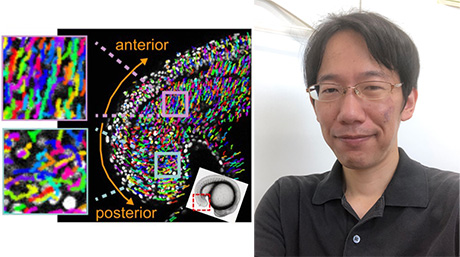生命理工学系 News
【研究室紹介】 山口研究室
生命の分子機械が働く「しくみ」をとことん明らかにし、応用展開を目指す!
生命理工学系にはライフサイエンスとテクノロジーに関連した様々な研究室があり、基礎科学と工学分野の研究のみならず、医学や薬学、農学等、幅広い分野で最先端の研究が活発に展開されています。
研究室紹介シリーズでは、ひとつの研究室にスポットを当てて研究テーマや研究成果を紹介。今回は、生命の分子機械の「しくみ」を解明し、応用展開を目指す、山口研究室です。
※居室を修正しました。2023年6月7日
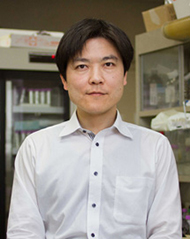
主担当 生命理工学コース
教授 山口雄輝![]()
| キーワード | 遺伝子発現、ゲノム、創薬、ケミカルバイオロジー |
|---|---|
| Webサイト | 山口研究室 |
研究紹介
当研究室では生命科学を基盤とし、基礎から応用まで幅広く研究を展開しています。
1. ゲノム情報発現の制御機構の解明
当研究室では、ゲノムから機能的RNAが作り出されるまでの過程―すなわちエピジェネティック制御、転写の開始・伸長・終結、RNAプロセシングという一連の過程―の解明を目指しています。
我々の体を構成する1つ1つの細胞は、同一のゲノムを持っているにも関わらず多彩な機能を果たしています。これは、ゲノム情報の発現が時空間的に極めて巧妙に制御されているためです。
当研究室では、ゲノム情報発現の過程を制御するタンパク質因子群を同定し、それらの働きを詳しく解析しています。
こうした地道な基礎研究の積み重ねは、一例を挙げればES細胞がES細胞らしい性質を持っているしくみの解明などに役立ちます。
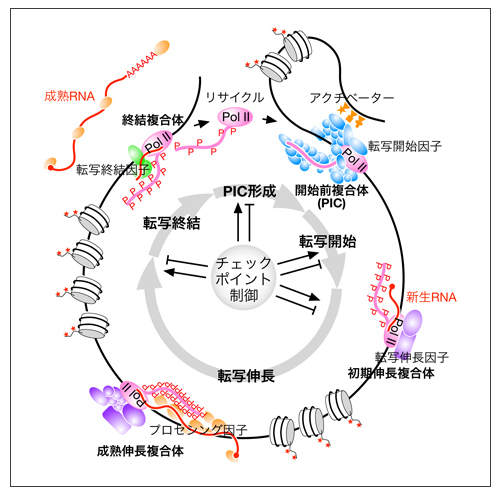
2. 医薬品などの低分子化合物を用いたケミカルバイオロジー
複雑な生体システムを研究する上で、低分子化合物は非常に有効なツールです。
ある化合物が生体に影響するしくみの解明は、標的タンパク質が関与する未知の生体内分子ネットワークの解明につながります。
さらに、用いた化合物が医薬品の場合、こうした知見は創薬にもつながります。
ケミカルバイオロジーというのは、こうした課題に取り組む学際的な研究分野で、当研究室では独自のアフィニティーナノ粒子を用いた薬剤標的タンパク質の単離・同定をベースに研究を進めています。
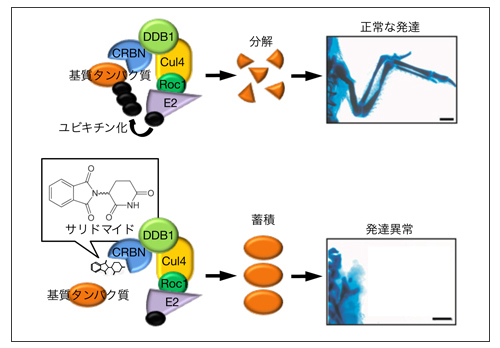
研究成果
代表論文
- ゲノム発現制御機構
- [1] Cao, Q.-F., Yamamoto, J., Isobe, T., Tateno, S., Murase, Y., Chen, Y., Handa, H., and Yamaguchi, Y. (2015) Characterization of the human transcription elongation factor Rtf1: evidence for non-overlapping functions of Rtf1 and the Paf1 complex. Mol. Cell. Biol. 35, 3459-3470.
- [2] Yamamoto, J., Hagiwara, Y., Chiba, K., Isobe, T., Narita, T., Handa, H., and Yamaguchi, Y. (2014) DSIF and NELF interact with Integrator to specify the correct post-transcriptional fate of snRNA genes. Nat. Commun. 5, 4263.
- [3] Chiba, K., Yamamoto, J., Yamaguchi, Y., and Handa, H. (2010) Promoter-proximal pausing and its release: molecular mechanisms and physiological functions. Exp. Cell Res. 316, 2723-2730. (review)
- [4] Chen, Y., Yamaguchi, Y., Tsugeno, Y., Yamamoto, J., Yamada, T., Nakamura, M., Hisatake, K., and Handa, H. (2009) DSIF, the Paf1 complex, and Tat-SF1 have non-redundant, cooperative roles in RNA polymerase II elongation. Genes Dev. 23, 2765-2777.
- [5] Narita, T., Yung, T.M.C., Yamamoto, J., Tsuboi, Y., Tanabe, H., Tanaka, K., Yamaguchi, Y., and Handa, H. (2007) NELF interacts with CBC and participates in 3'-end processing of replication-dependent histone mRNAs. Mol. Cell 26, 349-365.
- [6] Yamada, T., Yamaguchi, Y., Inukai, N., Okamoto, S., Mura, T., and Handa, H. (2006) P-TEFb-mediated phosphorylation of the hSpt5 C-terminal repeats is critical for processive transcription elongation. Mol. Cell 21, 227-237.
- [7] Aiyar, S.E., Sun, J.-L., Blair, A.L., Moskaluk, C.A., Lv, Y., Ye, Q.-N., Yamaguchi, Y., Mukherjee, A., Ren, D.-M., Handa, H., and Li, R. (2004) Attenuation of estrogen receptor alpha-mediated transcription through estrogen-stimulated recruitment of a negative elongation factor. Genes Dev. 18, 2134-2146.
- [8] Wu, C.-H., Yamaguchi, Y., Benjamin, L.R., Horvat-Gordon, M., Washinski, J., Enerly, E., Larsson, J., Lambertsson, A., Handa, H., and Gilmour, D.S. (2003) NELF and DSIF cause promoter proximal pausing on the hsp70 promoter in Drosophila. Genes Dev. 17, 1402-1414.
- [9] Narita, T., Yamaguchi, Y., Yano, K., Sugimoto, S., Chanarat, S., Wada, T., Kim, D., Hasegawa, J., Omori, M., Inukai, N., Endoh, M., Yamada, T., and Handa, H. (2003) Human transcription elongation factor NELF: Identification of novel subunits and reconstitution of the functionally active complex. Mol. Cell. Biol. 23, 1863-1873.
- [10] Yamaguchi, Y., Filipovska, J., Yano, K., Furuya, A., Inukai, N., Narita, T., Wada, T., Sugimoto, S., Konarska, M.M., and Handa, H. (2001) Stimulation of RNA polymerase II elongation by hepatitis delta antigen. Science 293, 124-127.
- [11] Guo, S., Yamaguchi, Y., Schilbach, S., Wada, T., Lee, J., Goddard, A., French, D., Handa, H., and Rosenthal, A. (2000) A regulator of transcriptional elongation controls vertebrate neuronal development. Nature 408, 366-369.
- [12] Yamaguchi, Y., Takagi, T., Wada, T., Yano, K., Furuya, A., Sugimoto, S., Hasegawa, J., and Handa, H. (1999) NELF, a multisubunit complex containing RD, cooperates with DSIF to repress RNA polymerase II elongation. Cell 97, 41-51.
- [13] Wada, T., Takagi, T., Yamaguchi, Y., Ferdous, A., Imai, T., Hirose, S., Sugimoto, S., Yano, K., Hartzog, G.A., Winston, F., Buratowski, S., and Handa, H. (1998) DSIF, a novel transcription elongation factor that regulates RNA polymerase II processivity, is composed of human Spt4 and Spt5 homologs. Genes Dev. 12, 343-356.
- ケミカルバイオロジー
- [1] Kabe, Y., Nakane, T., Koike, I., Yamamoto, T., Sugiura, Y., Harada, E., Sugase, K., Shimamura, T., Ohmura, M., Muraoka, K., Yamamoto, A., Uchida, T., Iwata, S., Yamaguchi, Y., Krayukhina, E., Noda, M., Handa, H., Ishimori, K., Uchiyama, S., Kobayashi, T., and Suematsu, M. (2016) Haem-dependent dimerization of PGRMC1/sigma-2 receptor facilitates cancer proliferation and chemoresistance. Nat. Commun. 7, 11030.
- [2] Sakamoto, S., Omagari, K., Kita, Y., Mochizuki, Y., Naito, Y., Kawata, S., Matsuda, S., Itano, O., Jinno, H., Takeuchi, H., Yamaguchi, Y., Kitagawa, Y., and Handa, H. (2014) Magnetically-promoted rapid immunoreactions using functionalized fluorescent magnetic beads. Clin. Chem. 60, 610-620. (review)
- [3] Gupta, V., Liu, S., Ando, H., Ishii, R., Tateno, S., Kaneko, Y., Yugami, M., Sakamoto, S., Yamaguchi, Y., Nureki, O., and Handa, H. (2013) Salicylic acid induces mitochondrial injury by inhibiting ferrochelatase heme biosynthesis activity. Mol. Pharmacol. 84, 824-833.
- [4] Karasawa, S., Azuma, M., Kasama, T., Sakamoto, S., Kabe, Y., Imai, T., Yamaguchi, Y., Miyazawa, K., and Handa, H. (2012) Vitamin K2 covalently binds to Bak and induces Bak-mediated apoptosis. Mol. Pharmacol. 83, 613-620.
- [5] Ito, T., Ando, H., Suzuki, T., Ogura, T., Hotta, K., Imamura, Y., Yamaguchi, Y., and Handa, H. (2010) Identification of a primary target of thalidomide teratogenicity. Science 327, 1345-1350.
- [6] Sakamoto, S., Kabe, Y., Hatakeyama, M., Yamaguchi, Y., and Handa. H. (2009) Development and application of high-performance affinity beads: toward chemical biology and drug discovery. Chem. Rec. 9, 66-85. (review)
著書
- [1] 近藤科江,山口雄輝(監修):理系英会話アクティブラーニング2 テツヤ、ディスカッションしようか, 羊土社, 2014.
- [2] 近藤科江,山口雄輝(監修):理系英会話アクティブラーニング1 テツヤ、国際学会いってらっしゃい, 羊土社, 2014.
- [3] 山口雄輝,成田央:基礎からしっかり学ぶ生化学, 羊土社, 2014.
- [4] Hiroshi Handa and Yuki Yamaguchi. Hepatitis Delta Virus, Landes Bioscience, Texas, USA, 2006.
- [5] 半田宏, 和田忠士, 山口雄輝. 転写研究集中マスター, 羊土社, 2005.
- [6] 山口雄輝. 科学英語論文の赤ペン添削講座, 羊土社, 2005.
教員紹介
山口雄輝 教授(工学博士)
| 1999年 | 東京工業大学 大学院生命理工学研究科バイオテクノロジー専攻 博士課程修了、博士(工学)を取得 |
|---|---|
| 1999 - 2001年 | 日本学術振興会 特別研究員 |
| 2001 - 2005年 | JSTさきがけ プログラム研究者 |
| 2002 - 2007年 | 東京工業大学 大学院生命理工学研究科 生命情報専攻 助手 |
| 2007 - 2008年 | 同助教 |
| 2009 - 2013年 | 同准教授 |
| 2013年より | 現職 |
| 2011年10月 | 東工大挑戦的研究賞 |
|---|---|
| 2011年2月 | 手島記念研究賞 研究論文賞 |
| 2000年12月 | Amersham Pharmacia Biotech & Science Prize |
| 2000年5月 | 手島記念研究賞 博士論文賞 |
- 教育活動
- 学部:科学・技術の最前線、科学・技術の創造プロセス、生命科学基礎、生物化学第二、生命理工学基礎実験4
- 大学院:Molecular and Cellular Biology、長寿社会と生命、Global Communication、Global Presentation、Global Debate、Global Writing、LST Academic Writing 2
- 所属学会
- 日本分子生物学会
教員からのメッセージ
- 山口教授より
-
当研究室では生命科学を基盤とし、基礎から応用まで幅広く研究を展開しています。
それらの根底にあるのは、生命という複雑な分子機械の動作原理を解明したいというという熱い思いです。
生化学や分子生物学の新しい技術・手法をどんどん取り入れながら「ゲノム情報発現」や「くすりの作用機構」の研究を進めているので、やる気のある皆さんの参加を待っています。
- 研究室と研究テーマ
- 転写時のRNAの長さを制御する仕組みが明らかに ―がん化のメカニズム解明につながると期待―|東工大ニュース
- 過剰な炎症反応を抑える仕組みを解明 -関節リウマチなど自己免疫疾患の病態が明らかに-|東工大ニュース
お問い合わせ先
教授 山口雄輝
すずかけ台キャンパスB1棟 417号室
E-mail : yyamaguc@bio.titech.ac.jp
※この内容は掲載日時点の情報です。最新の研究内容については研究室サイト![]() をご覧ください。
をご覧ください。
※ 2025年5月1日:一部最新の情報に更新しました。
